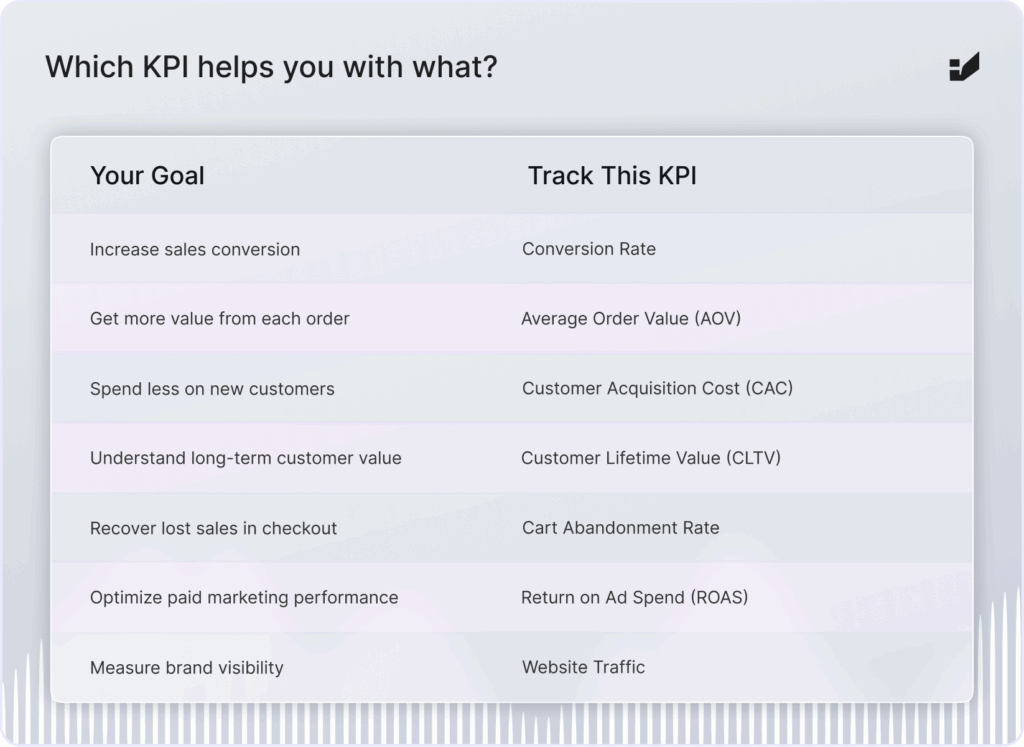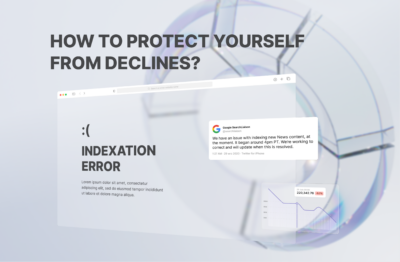7 most important e-commerce KPIs for growth
Tracking the right data is crucial for making informed decisions in e-commerce. With hundreds of metrics available, it’s easy to get lost. But not all numbers are equally useful.

Focusing on a few core KPIs gives you clarity. These indicators highlight how well your store attracts, converts, and retains customers and where there’s room to improve. Whether you’re just starting or scaling up, keeping an eye on these numbers will help you grow efficiently and sustainably. Below you can find 7 essential KPIs every online store should track.

1. Conversion rate (CR)
Conversion Rate is one of the most direct indicators of your store’s performance. It tells you whether your visitors are simply browsing or making a purchase. If you’re driving traffic but not seeing sales, this number will show you the gap. Improving it can make a significant difference, often more quickly than chasing more clicks or impressions.
What it measures:
The percentage of website visitors who complete a purchase.
Formula:
CR = (Number of Sales / Number of Visitors) × 100%
Why it matters:
This indicates how effectively your store converts traffic into actual sales. A strong conversion rate means your site is user-friendly, your offer is clear, and your marketing brings in the right people.
How to improve:
- Make navigation simple and intuitive
- Shorten the checkout process
- Use high-quality images and detailed product descriptions
- Run A/B tests on buttons, copy, and layout
- Highlight your value clearly on each page

2. Average order value (AOV)
AOV shows how much money customers typically spend in one transaction. It gives you insight into the purchasing habits of your audience. If your traffic is steady but revenue feels stuck, working on this metric can move the needle. Often, encouraging shoppers to spend just a bit more is easier than attracting entirely new visitors.
What it measures:
The average amount spent per transaction.
Formula:
AOV = Total Revenue / Number of Orders
Why it matters:
Boosting AOV increases your revenue without needing more traffic. It’s often cheaper to get customers to spend more than to find new ones.
How to improve:
- Suggest complementary products (cross-sell)
- Offer bundles or volume discounts
- Add free shipping above a certain amount
- Use personalized product recommendations
3. Customer acquisition cost (CAC)
Getting customers to visit and buy from your store isn’t free. CAC tells you how much it costs to convince someone new to make a purchase. It connects your marketing spend to real results, helping you decide whether your efforts are paying off. If you’re spending more to get customers than they bring in, it’s time to rethink the strategy.
What it measures:
The cost of acquiring a single customer.
Formula:
CAC = Total Marketing and Sales Spend / Number of New Customers
Why it matters:
Knowing how much it costs to bring in a customer helps you assess if your marketing is profitable and sustainable in the long run.
How to improve:
- Fine-tune your audience targeting
- Invest in SEO and content to reduce paid costs
- Increase website conversion rates
- Launch referral programs
- Cut underperforming ad channels
4. Customer lifetime value (CLTV)
Some customers buy once and never come back. Others keep returning and spending more over time. CLTV helps you understand the long-term revenue potential of each customer. It shifts your focus from one-off transactions to building lasting relationships that pay off in the long run. The higher the CLTV, the more freedom you have to invest in retention and acquisition.
What it measures:
The total revenue you expect from one customer over time.
Formula:
CLTV = AOV × Purchase Frequency × Customer Lifespan
Why it matters:
CLTV shows the long-term value of each customer. It helps you decide how much you can afford to spend on acquiring and keeping them.
How to improve:
- Strengthen customer relationships
- Offer loyalty programs
- Personalize emails and offers
- Provide excellent support
- Use retargeting and re-engagement campaigns
5. Cart abandonment rate
Many shoppers show clear buying intent. They browse, pick products, and add them to the cart. Then they leave without completing the purchase. This metric reveals where the buying journey breaks down. Fixing issues at this stage is often one of the quickest ways to boost revenue without driving more traffic.
What it measures:
The percentage of shoppers who add items to their cart but don’t finish the purchase.
Formula:
Abandonment Rate = [(Carts Created – Completed Purchases) / Carts Created] × 100%
Why it matters:
This metric points to friction in the buying process. Reducing abandonment can lift your revenue without extra traffic.
How to improve:
- Simplify checkout
- Offer guest checkout
- Be upfront about shipping and return policies
- Include multiple payment options
- Send reminder emails with incentives

6. Return on ad spend (ROAS)
Spending money on ads is only worth it if it brings sales. ROAS helps you see which campaigns are delivering results and which ones are wasting budget. It gives you a clear picture of how well your advertising converts spend into revenue. This insight guides your decisions on where to focus your marketing budget for the best return.
What it measures:
The revenue earned for every dollar spent on advertising.
Formula:
ROAS = Revenue from Ads / Ad Spend
Why it matters:
It shows how effectively your ads are converting spend into sales. A solid ROAS means your campaigns are on track.
How to improve:
- Sharpen your ad targeting
- Test creatives and messaging
- Improve landing page quality
- Track results by channel and reallocate budget as needed
7. Website traffic
Website traffic is the foundation of your e-commerce success. Without visitors, there are no sales opportunities. Tracking how many people come to your store lets you see how well your marketing efforts attract potential customers. It also helps you spot trends and seasonal changes, so you can plan your campaigns better. Understanding traffic sources allows you to focus on the most effective channels and improve your overall reach.
What it measures:
The number of people visiting your site.
Why it matters:
No traffic means no sales. Tracking this helps you understand your brand’s reach and how well your channels bring people in.
How to improve:
- Optimize for SEO
- Promote content via social media
- Run paid campaigns on search and social
- Create valuable content that drives clicks
- Build an email list to bring people back

Tracking these seven KPIs will give you a solid overview of your store’s health. More importantly, they help you focus your time and budget where it counts – turning visitors into loyal customers and growing your revenue over time.


